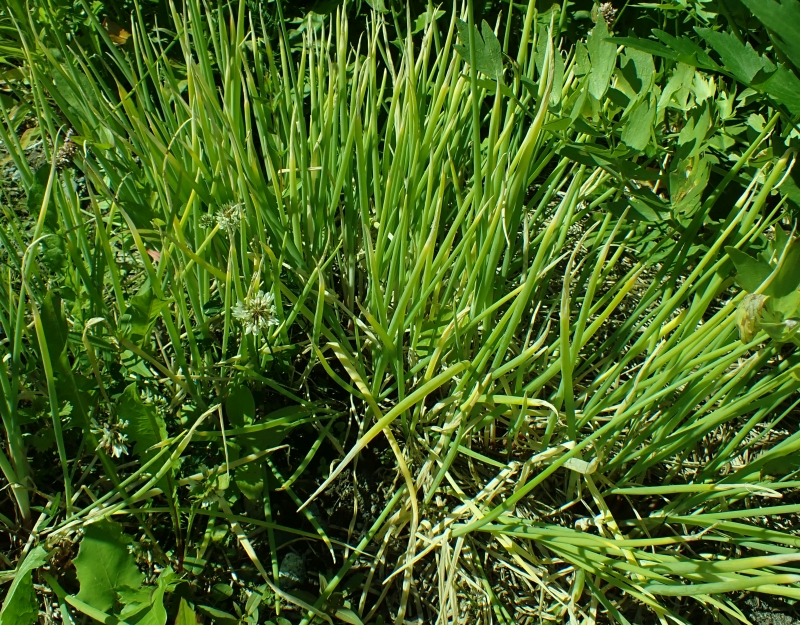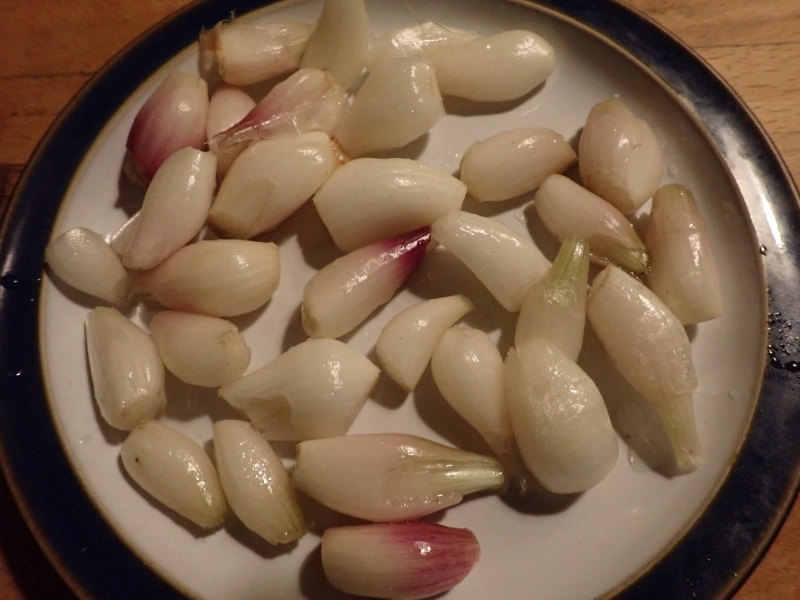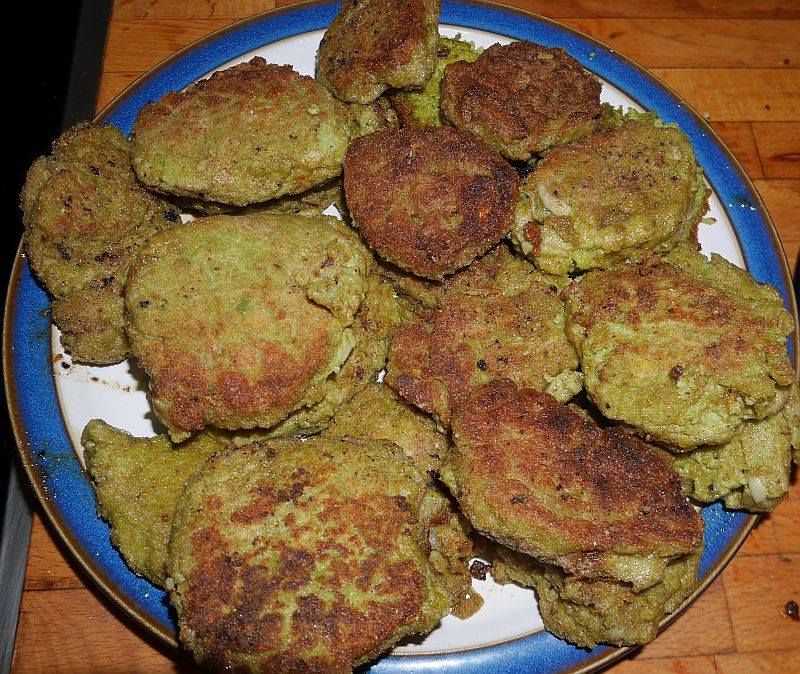The first time a siskin (grønnsisik) decided to pay me a visit, found yesterday inside the house (a young bird)! 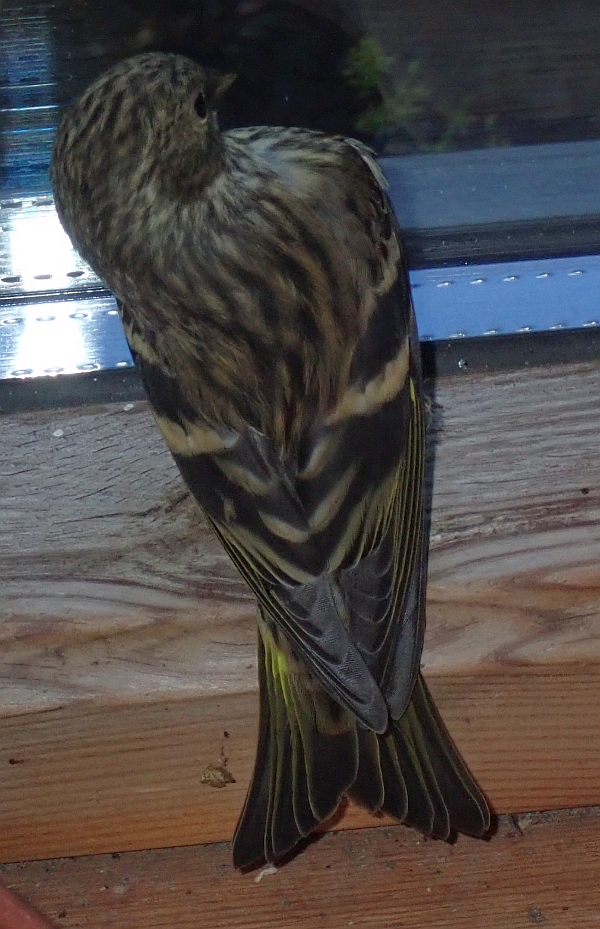
Toad lilies: great edientomentals
Toad lilies (Tricyrtis sp.) are great edientomentals from the Far East; i.e. both food for us to eat (the edi bit), eye food (the mental bit ;) ) and food for the pollinators like bumble bees (the ento bit).
I’ve been meaning to try to research this genus properly for many years ever since I ate the young shoots 10 years ago (it tasted mild and good). I’ve tried 10+ species over the years, but only the early flowering species thrive (Tricyrtis latifolia is I think the most successful of the two). Bumble bees love them too as can be seen in the video below!
Below the pictures is an overview of how different species Tricyrtis are used in Japan. It indicates that the flowers can also be used at least in moderation for decoration, so I must give it a go!


Tricyrtis in the kitchen
All I have so far is that 6 or 7 species are listed in my comprehensive Japanese foraging book (in Japanese): Wild Food Lexicon (Japan) and this is what it says (there are no warnings of possible toxicity and it encourages the reader to get and grow a couple of the species):
Tricyrtis latifolia (Tamagawa hototogisu)
Eat young shoots. You can eat other types of Tricyrtis so don’t worry if you make a mistake. Rest assured. You can pick it even if the stems are long, you can pick the soft young shoots until they bloom.
Boil in hot water with a pinch of salt, then rinse in cold water. In boiled food, soup, tempura…
Tricyrtis macropoda
It can be eaten like Tamagawa hototogisu, but the ones with a lot of hairs have an inferior taste.
Tricyrtis macrantha
Boiled soup. For tempura etc. It has a crisp texture. Boil briefly, soak in cold water, boil, cut into small pieces and season with mustard. The young shoots are the most flavourful amongst the hototogisu.
Tricyrtis macranthopsis
Seedlings for cultivation are on the market. You can grow it and use it as food.
Around May, pick young shoots that grow diagonally. Even those with long stems can be eaten by picking the soft part at the tip of the stem.
Tricyrtis perfoliata
Young shoots are “hard”? in quality. Floating the flowers in the soup and enclosing them in jelly will make them beautiful. Get it, grow it and taste it!!
Poplar Hawk Moth / Ospesvermer
The last time I saw one of these in the garden was in 1998: poplar hawk moth / ospesvermer. Today, one turned up in my light trap, and I’m sure anyone passing would have heard a loud WOW coming from the woods! More information and a picture of the 1998 moth here.
It was reluctant to take to the wing and needed some encouragement as can be seen in the videos and you can pick it out flying off through the woods…

The Onion Garden Chicago on 3rd July 2024
The Onion Garden Chicago at the Ringve Botanical Garden in Trondheim, Norway contains over 100 Allium species and over 400 different accessions including a collection of old Norwegian onions which I collected across the country with support from the Norwegian Genetic Resource Centre and the Norwegian Agricultural Authority. You can safely eat all Alliums and most species have in the past been wild foraged. A few do have an unpleasant taste, but most are good to eat including some of the best-known ornamental onions, some of the best edimentals (combined food and beauty) and edi-ento-mentals: also a very popular genus for pollinators like bumble bees. Members of KVANN (Norwegian Seed Savers) in Norway can order most of the Alliums grown in the garden each autumn (please support us by becoming a member at https://kvann.no/bli-med)
These are the 40 main Alliums I talk about, in order of appearance: Allium cernuum (nodding onion; Chicago onion; prærieløk) Allium cernuum “Alan Kapuler”(nodding onion; Chicago onion; prærieløk) Allium canadense Allium fistulosum (rooftop onion; takløk from the Gudbrandsdalen valley) a) From Søre Kleivmellomsæter, Mysusæter in Rondane at 885m asl b) From Nordre Geitsida, Sel municipality Allium cyathophorum var. cyathophorum Allium hymenorhizum Allium insubricum Allium validum (Pacific or swamp onion from California) Allium scorodoprasum (sand leek; bendelløk – garlic derives from old norse geirlauk meaning spear onion as demonstrated) Allium tricoccum (ramps) Allium caeruleum “Bulbilliferous form” Allium wallichii (Sherpa or Nepal onion) Allium senescens (Siberian onion) Allium fistulosum (Welsh onion; pipeløk) from Skedsmokorset, Akershus Allium sativum (hardneck / serpent garlic; slangehvitløk) Allium victorialis “Cantabrica” from northern Spain (Victory onion; seiersløk) Allium victorialis “Røst, Norway” from the island in the Lofoten Islands in Norway (Victory onion; seiersløk) Allium x proliferum “Catawissa onion” (topset, Egyptian or walking onions; luftløk, etasjeløk) Allium pskemense (tower onion; tårnløk) Allium pskemense x fistulosum “Wietse’s onion” Allium ochotense from Japan (earlier Allium victorialis) Allium carolinianum Allium moly (golden garlic, lily leek; gull-løk) Allium caesium Allium schoenoprasum (chives; gressløk) – deadheaded Allium douglasii (Douglas’ onion; Douglasløk) Allium cernuum “Dwarf White” (nodding onion; Chicago onion; prærieløk) Allium prattii x ovalifolium? (Chinese hybrid) Allium galanthum Allium rotundum Allium schoenoprasum subsp. sibiricum “Hokkaido” – later flowering than other chives Allium ovalifolium var. leuconeurum Allium flavum subsp. flavum var. minus (small yellow onion; doggløk) Allium ramosum Allium stipitatum (Persian shallots; Persisk sjalott) Allium maximowiczii var shibutsuense f. album Allium victorialis “Landegode, Nordland, Norway” (Victory onion; seiersløk) Allium nutans “Lena” (Siberian nodding onion; Sibirsk nikkeløk) Allum lenkoranicum
A pulsating snail in the garden!
This must qualify as the weirdest organism I’ve found in my garden and likely to give me nightmares, so you are warned! A snail and bird parasite that develops in the snail’s tentacles, mimicking a caterpillar by pulsating. I had never heard of such a thing and wondered what the hell was going on, some kind of weird snail sex or maybe some psychedelic mushroom had got into the dinner! The snail is an amber snail / storravsnegl (Succinea putris).
An explanation of the part of the life cycle of the green-banded broodsac or Leucochloridium paradoxum I had witnessed can be read below the video and pictures.


The following is copied from https://animaldiversity.org/accounts/Leucochloridium_paradoxum
“Two visible changes in the snail occur as a result of the accumulation of sporocysts. First, the snail’s tentacles enlarge and pulse in vivid colors. Secondly, the instinctively photophobic snail becomes photophylic and climbs to the tops of trees and grasses. This conspicuous sight looks like a caterpillar to passing birds. The birds swoop down and consume the snail and unknowingly inoculate themselves with Leucochloridium paradoxum. The worm continues its development within the bird’s gut and ultimately ends up in the rectum where its eggs are flushed out with waste. Another snail consumes the excreted egg and the cycle continues”
Silent Spring / Den Tause Våren
Rachel Carsons Den tause våren er her i Malvik, iallefall på jordene rundt Malvik sentrum og Vikhammer, men jeg har ikke kunne lese noe om dette i avisene. For meg som følge tett med naturen og særlig fuglene våre er det dramatisk! For første gang siden jeg flyttet til Malvik i 1981 (43 år) er et av de vakreste sangene HELT BORTE fra lydbildet. Det dreier seg om storspoven, en stor fjære- og dyrkamark tilknyttet fugleart (se videoen helt nederst for å forstå hva som er borte):

Dette er en fugl jeg gleder meg til å høre hver vår når den dukker opp vanligvis i første uke i april og ofte hver dag frem til begynnelsen av juli hører jeg den nede i Malvikbukta eller trekkende over huset mot Vikhammer. Den etterhvert eneste par i Malvik kommunen har letet etter mat både på dyrkamark og i fjæra, nedenfor huset mitt i Malvikbukta og på Vikhammer. I år var ankomsten rekord tidlig og jeg hørte sangen allerede 29. mars, men det er blitt helt stille siden, noe som gir meg stor natursorg. Hva som er årsaken til dette vet jeg ikke sikkert, men nedbygging av dyrkamark på Vikhammer, økt ferdsel i fjæra der og motorveiutbyggingen ved Leistad jordene der det mistenkes at fuglene har hekket i en årrekke har sikkert alle bidratt. Jeg har vært urolig for at dette kunne skje i flere år. Vi mistet en annen fugl tilknyttet dyrkamark for ca 8 år siden – vipe, en art som er nå regnet som kritisk truet i Norge . Ifjor 8. august oppdaget jeg noe merkelig i at en ung storspove satt på et hustak nedenfor huset mitt i Malvik sentrum mens foreldrene letet etter mat på mudderflatene nedenfor (video)! Forhåpentligvis blir ikke dette den siste storspove-unger i Malvik….
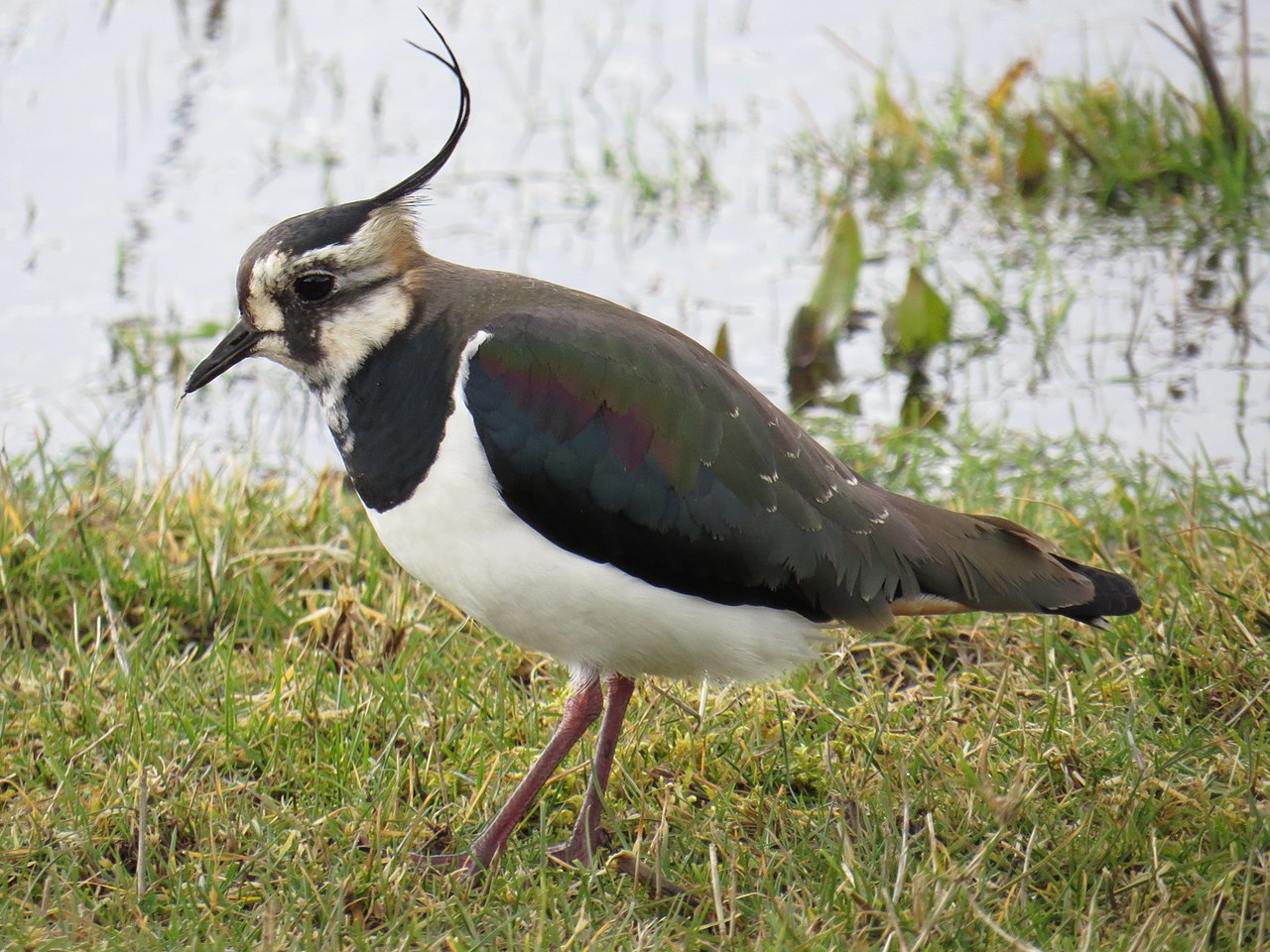
Jeg savner stort lyden av storspove og vipe! Jeg savner også sangen av låvesvalen over hagen min, en art som nå er helt bort som hekkefugl fra Malvik til Hundhamaran siden det ikke lenger er hekkeplasser å oppdrive for arten, stæren har også blitt en sjeldenhet og gulspurv er kommet på rødlista som sårbar. Nedbygging av dyrkamark på Vikhammer kan også truer det største overnattingsted for kaiene (en liten kråkefugl) slik jeg har skrevet om tidligere. Fellesnevnen for alle disse artene er at de er tilknyttet dyrkamark og er avhengig av vår hjelp!
KONKLUSJONEN: DEN TAUSE VÅREN HAR ALLEREDE KOMMET TIL MALVIK…
Til slutt en liten minne av storspove sang tatt fra huset mitt i Malvik like før soloppgang 20. april 2020 der man kan høre en rekke andre fuglearter i hagen like før soloppgang! Jeg håper at politikerene i Malvik gjør alt mulig for at dette er noe fremtidig generasjoner også vil kunne glede seg til!
Sochan and Moly scrambled egg Meditteranean style
Lunch today was inspired by the Mediterranean diet – simple with masses of greens, but with an international twist: Cherokee spinach (top shoots of sochan – Rudbeckia laciniata / kyss-meg-over-gjerde), nettles (nesle), shallots (sjalott) harvested and stored since October, greater musk mallow (rosekattost) (Malva alcea), day lilies (dagliljer) flower buds, sand leek (bendelløk) (Allium scorodoprasum) and nodding onion / prærieløk (Allium cernuum) flowers. Added wild oregano (Origanum vulgare), dried orange milkcap / Granmatrisken (Lactarius deterrimus) and home grown chili salt a la “Are Sende Osen” (a gift during his visit this week), served with Allium moly flowers (from the mountains of Spain).

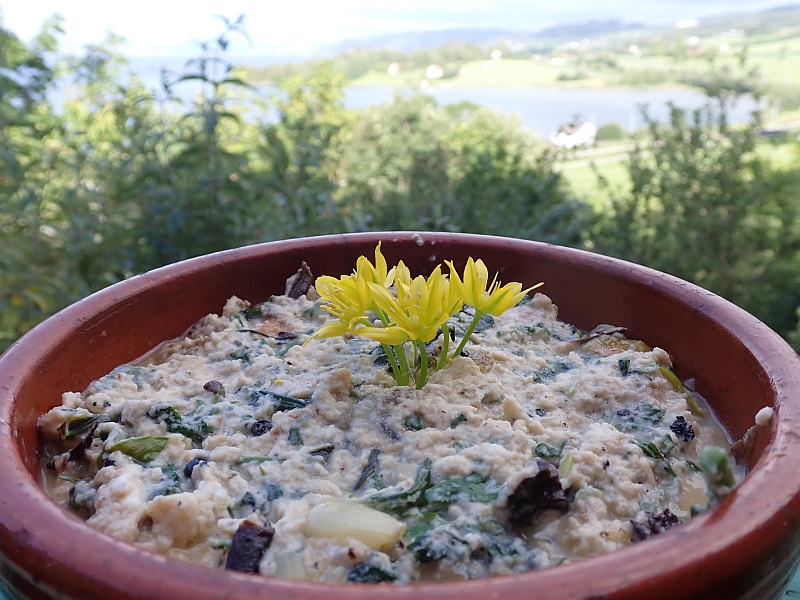


The Balcony in the rain
Wonderful rain on the balcony (aka zone 0.5) with oca (Oxalis tuberosa), 9 varieties of lettuce (salat), tomato “42 days” , dill, coriander, toothache pant (Spilanthes), shungiku / kronkrage and lots of celery (around the corner). The large bucket in the corner contains burdock providing seed fot goldfinches (stillits) and greenfinches (grønnfink) in winter (a living bird feeder!)
Hagevandring med Malvik Hagelag
Dette var kanskje den 10. gangen Malvik Hagelag hadde vært på hagevandring hos meg, over en snart 40 års periode! Jeg meldte meg inn i hagelaget og var med på møtene fra midten av 80-tallet. Den gangen var jeg den yngste (de fleste medlemmer var pensjonister). Det var derfor interessant å reflektere over at nå hadde jeg kanskje blitt eldst!
Det var en flott sommerkveld og 30C og noen meldte avbud pga temperaturen! Men, det var en fin gjeng som var med og hørte på mine bortforklaringer for hvorfor hagen hadde blitt så vill….hadde jeg mistet kontroll i mine gamle dager? Neida…..bare sluppet kontroll bevisst og overført kontrollen til mine to andre hagene på Væres Venners felleshagen og Løkhagen Chicago!
Og denne gangen hadde de bestilt en salat, og det ble ca 130 forskjellige spiselige planter. Årets første jordbær og rips ble ofret og blomsterstander av gulblomstret Allium hookeri var muliense, Allium cernuum mfl. Vi avsluttet med plante- og boksalg!


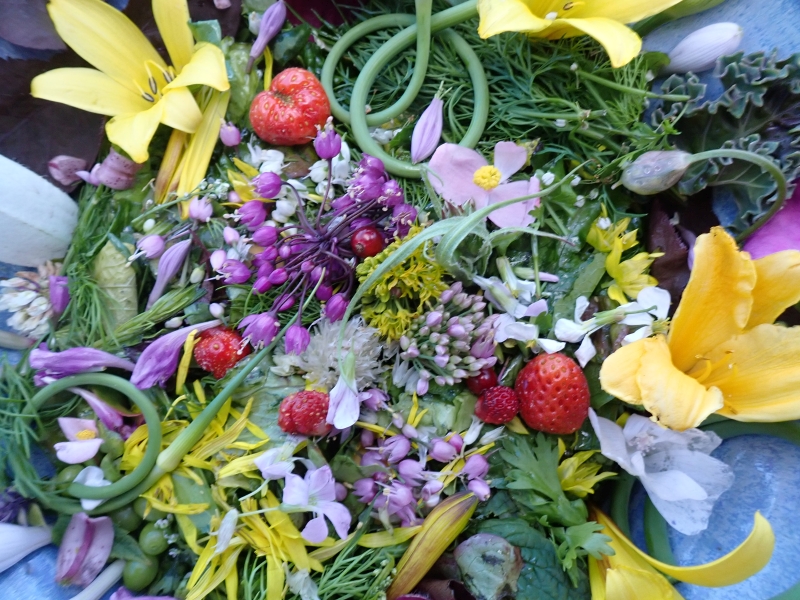



Saint John’s Eve Felafels
Yesterday was St. John’s Eve and many Norwegians (and other Scandinavians) celebrated what is known here as Sankthans or Jonsok with communal bonfires, the big midsummer celebration. Sankt Hans is a short form of Sankt Johannes. There is a special perennial onion which was traditionally harvested on this day in the Netherlands, which I believe to have a much large potential than its current status as a local food crop, as it is so much easier to grow, in particular in areas increasingly suffering from summer droughts and water shortages and avoids common pests of onions and shallots by its early growth and perhaps also resistance. If nothing else, it complements shallots and onions in that it is available much earlier in the year!
There is genetic evidence that St. John’s onion (Johannes-løk) has a unique triparental origin A. × cornutum with three putative parental species, A. cepa, A. pskemense, and A. roylei. Hardiness is probably bestowed by hardy Allium pskemense which has been growing in the Ringve Botanical Gardens in Trondheim for many years. A similar hybrid has been found both in Germany, Croatia and India. It was perhaps more widely cultivated in the past and these are just remnant populations. On 21st June I harvested the Croatian accession from the Onion Garden Chicago at the Ringve Botanical garden which had been left for two years resulting in hundreds of tightly packed onions and on 22nd June from the World Garden at the Væres Venner Community Garden. I replanted in both gardens single bulbs separated by about 10cm. in a roughly circular patch.
Last night, St. John’s Eve, I started a vegetarian midsummer tradition by making St. John’s Felafels with dried broad beans stored since the autumn and golpar spice (from dried seeds of a mix of Heracleum sp.).
See more about Johannes’ shallot at https://www.edimentals.com/blog/?p=22601